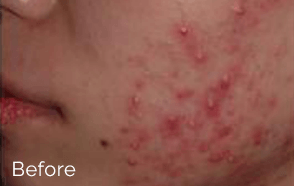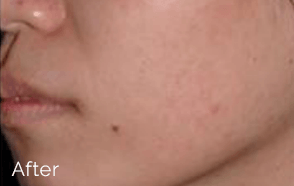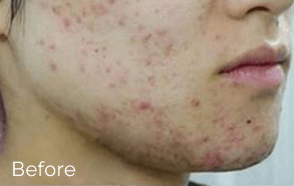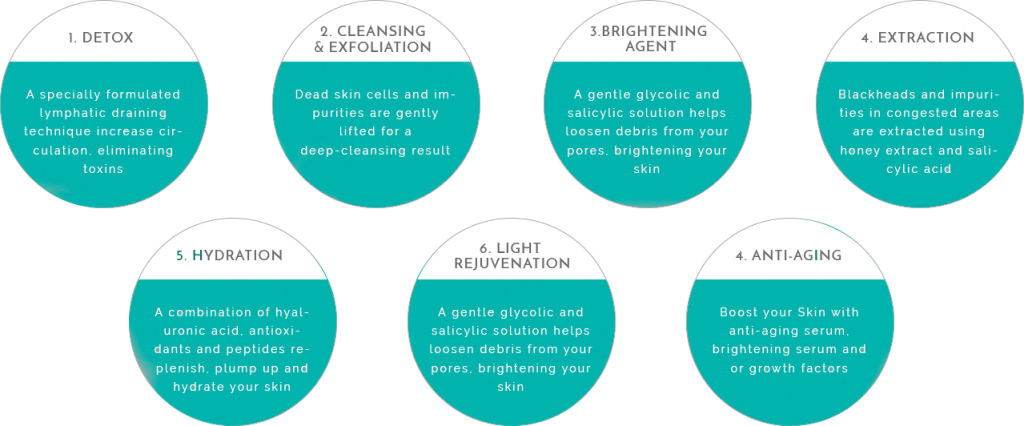A HydraFacial treatment is comfortable and painless. Your medical aesthetician will use a handpiece to exfoliate the skin and extract impurities with a gentle suction, followed by a massaging motion as your customized skin solution is infused into the skin.
Results are visible on your first visit. As subsequent treatments unfold over the following weeks, these improvements will become increasingly prominent. Patients typically experience visible skin refinement as well as a smooth and radiant skin tone.
Frequency of treatment is dependent on your specific skin type and concerns, but HydraFacial MD may be applied every two weeks to maximize the dermatological skin benefits.
After receiving HydraFacial treatment, your practitioner will advise you on the best techniques to look after and maintain your new, cleansed appearance. Make-up can be worn immediately after the procedure, but we generally advise you refrain from any other skincare regimen until several hours later. In order to protect any sensitive areas from the effects of the sun, wearing sunscreen with an SPF of 30 or more is always advised.
During a HydraFacial, precautions include avoiding sun exposure, refraining from using retinoids or exfoliating products 48 hours before, and disclosing any skin conditions or allergies to the skincare professional for a safe and effective treatment.
After a HydraFacial, it’s advisable to avoid sun exposure, harsh skincare products, and intense physical activities for at least 24 hours to allow the skin to recover and maximize the benefits of the treatment.
The HydraFacial MD machine offers benefits such as deep exfoliation, gentle extraction, and infusion of customized serums, resulting in improved skin texture, reduced fine lines, and a hydrated, radiant complexion.
Individuals with active skin infections, sunburn, a history of recent laser treatments, or certain skin conditions may not be suitable candidates for a HydraFacial, and it’s essential to consult with a skincare professional to assess suitability.
After a HydraFacial, it’s advisable to avoid products containing harsh chemicals, retinoids, and exfoliating agents for the next 24 hours to prevent irritation and maximize the benefits of the treatment.
Washing your face immediately after a HydraFacial is generally not recommended, as it can disrupt the post-treatment serums and potentially irritate the skin; it’s best to follow the aftercare instructions provided by your skincare professional.
After a HydraFacial, do follow the recommended aftercare, avoid sun exposure, harsh skincare products, and vigorous exercise for 24 hours; don’t use retinoids or exfoliating agents during this period to ensure optimal results.
Healing time after a HydraFacial is minimal, with most individuals experiencing no downtime, allowing them to resume normal activities immediately after the treatment.
Before getting a HydraFacial, it’s important to disclose any skin conditions, allergies, or recent use of retinoids, and to avoid sun exposure and exfoliating products for 48 hours prior to the treatment for optimal results.
The HydraFacial offers deep exfoliation, hydration, and customization but may be relatively expensive, and individual results can vary depending on skin type and concerns.
HydraFacial is generally considered safe for sensitive skin, as it is a non-invasive treatment that can be customized to suit various skin types, but it’s advisable to consult with a skincare professional to ensure the treatment is tailored to individual sensitivities.
While noticeable improvements can be seen after one HydraFacial, a series of sessions, typically spaced a few weeks apart, may be recommended for more significant and long-lasting results, depending on individual skin concerns.
HydraFacial is generally suitable for sensitive skin, but it’s essential to communicate any specific sensitivities or concerns with your skincare professional to customize the treatment appropriately.
Common side effects of HydraFacial may include temporary redness, mild irritation, or tightness, but these are generally short-lived, and severe complications are rare when performed by a trained skincare professional.
Skin sensitivity after a HydraFacial is typically minimal, and any temporary redness or irritation usually subsides within a few hours, allowing individuals to resume regular activities.
After a HydraFacial, it’s advisable to wait at least 24 hours before exposing your skin to direct sunlight, using retinoids or harsh skincare products, and engaging in vigorous exercise to allow the skin to fully benefit from the treatment and avoid potential irritation.
It’s recommended to wait at least 6 hours before washing your face after a HydraFacial to allow the post-treatment serums to be fully absorbed and maximize the benefits of the procedure.
After a HydraFacial, it’s advisable to avoid putting water on your face for at least 6 hours to allow the post-treatment serums to be fully absorbed and optimize the results of the procedure.
After your first HydraFacial, you can expect improved skin hydration, a more radiant complexion, and minimized imperfections with little to no downtime, but individual experiences may vary.
The frequency of HydraFacial treatments varies based on individual skin concerns, but a series of sessions spaced several weeks apart is often recommended for optimal results, with maintenance treatments as desired. Spaced 4 week apart.
You may touch your face with clean hands after a hydrafacial procedure, you skin will feel soft and smooth.
While it’s generally advisable to avoid touching your face immediately after a HydraFacial to prevent potential irritation, following the post-treatment instructions provided by your skincare professional is essential for optimal results.
A HydraFacial typically involves four stages: cleansing and exfoliation, a gentle acid peel, painless extractions using a vortex suction, and the infusion of customized serums to hydrate and protect the skin.
It’s generally recommended to wait at least 6 hours before showering after a HydraFacial to allow the post-treatment serums to be fully absorbed, optimizing the benefits of the procedure.
HydraFacial is a non-invasive facial treatment that combines exfoliation, extraction, and hydration, delivering customized serums to improve skin texture, address specific concerns, and provide a refreshed complexion with minimal downtime.
HydraFacial is unique for its patented Vortex-Fusion technology, combining exfoliation, extraction, and infusion of customized serums, providing a comprehensive and customizable facial treatment with minimal discomfort and downtime.
The long-term benefits of HydraFacial include improved skin texture, reduced signs of aging, minimized hyperpigmentation, and enhanced overall skin health through regular treatments and a personalized skincare regimen.
HydraFacial can be performed on various areas of the body, with the face being the most common, but it is also suitable for the neck, chest, and hands to address specific skin concerns and promote overall skin health.
HydraFacial is generally safe and effective for acne-prone skin, as it helps unclog pores, remove impurities, and deliver targeted serums to promote clearer, healthier skin, but individual responses may vary.
The HydraFacial glow can last for several days to a week, depending on individual skin characteristics and the specific skincare routine followed post-treatment.
Itching after a HydraFacial may occur due to temporary skin sensitivity or reactions to specific products used during the treatment, and it’s advisable to consult with a skincare professional for appropriate guidance.
To maintain the benefits of a HydraFacial, follow a consistent skincare routine, avoid harsh products, protect your skin from sun exposure, and consider periodic HydraFacial treatments based on your individual needs and skincare goals.
While complications are rare, Hydrafacials can go wrong if performed by an untrained provider or if the individual has specific contraindications, emphasizing the importance of seeking qualified professionals for the procedure.
Although rare, allergic reactions to HydraFacial may occur due to individual sensitivities to the treatment’s ingredients, highlighting the importance of informing your skincare professional about any allergies beforehand.
HydraFacial typically involves four steps: cleansing and exfoliation, a gentle acid peel, painless extractions using vortex suction, and the infusion of customized serums to hydrate and protect the skin.
Hydrafacials are generally recommended to be spaced four to six weeks apart to allow the skin to fully recover and to maintain optimal results over time.
Yes, HydraFacial can be done every month, and a monthly treatment schedule is often recommended to maintain and optimize the benefits for healthy and radiant skin.
The “dirty water” seen during a HydraFacial is a combination of extracted impurities, dead skin cells, and debris removed from the skin during the exfoliation and extraction stages of the treatment.
Yes, a HydraFacial can help remove blackheads by using a vortex suction to extract impurities, unclog pores, and improve the overall appearance of the skin.
HydraFacial is beneficial for individuals of various skin types and concerns, addressing issues such as fine lines, wrinkles, uneven skin tone, and dehydration, making it a versatile treatment for overall skin health.
HydraFacial is named for its hydrating and facial rejuvenation properties, combining exfoliation, extraction, and infusion of customized serums to achieve a comprehensive and hydrating skincare treatment.
HydraFacials are generally effective at improving skin hydration, reducing fine lines, clearing congested pores, and enhancing overall skin texture in a single treatment session.
HydraFacial results are temporary and typically last for a few weeks to a month, requiring regular treatments for sustained benefits.
Potential disadvantages of HydraFacial may include temporary redness, sensitivity, or rare adverse reactions for some individuals.
Most individuals notice immediate improvements in skin hydration and texture immediately after a HydraFacial treatment.
HydraFacial is considered a non-invasive cosmetic treatment rather than a medical procedure.
Before getting a HydraFacial, it’s important to discuss any skin concerns or sensitivities with a skincare professional to determine suitability and potential outcomes.
While HydraFacial is suitable for many skin types, it may not be ideal for individuals with certain skin conditions or specific medical histories; thus, it’s essential to consult a skincare professional for personalized advice.
It’s generally recommended to avoid applying ice directly to the face immediately after a HydraFacial to allow the skin to naturally calm and benefit from the treatment’s effects.
HydraFacial can help improve skin tone and texture, potentially reducing the appearance of dark spots over multiple treatment sessions.





























 604-706-1503 (English)
604-706-1503 (English) 604-305-2098 (Chinese)
604-305-2098 (Chinese)
 604-305-2098 (English)
604-305-2098 (English) 604-305-2098 (Chinese)
604-305-2098 (Chinese)
 604-210-6319 (English)
604-210-6319 (English) 604-305-2098 (Chinese)
604-305-2098 (Chinese)
 604-265-7044 (English)
604-265-7044 (English) 604-305-2098 (Chinese)
604-305-2098 (Chinese)



